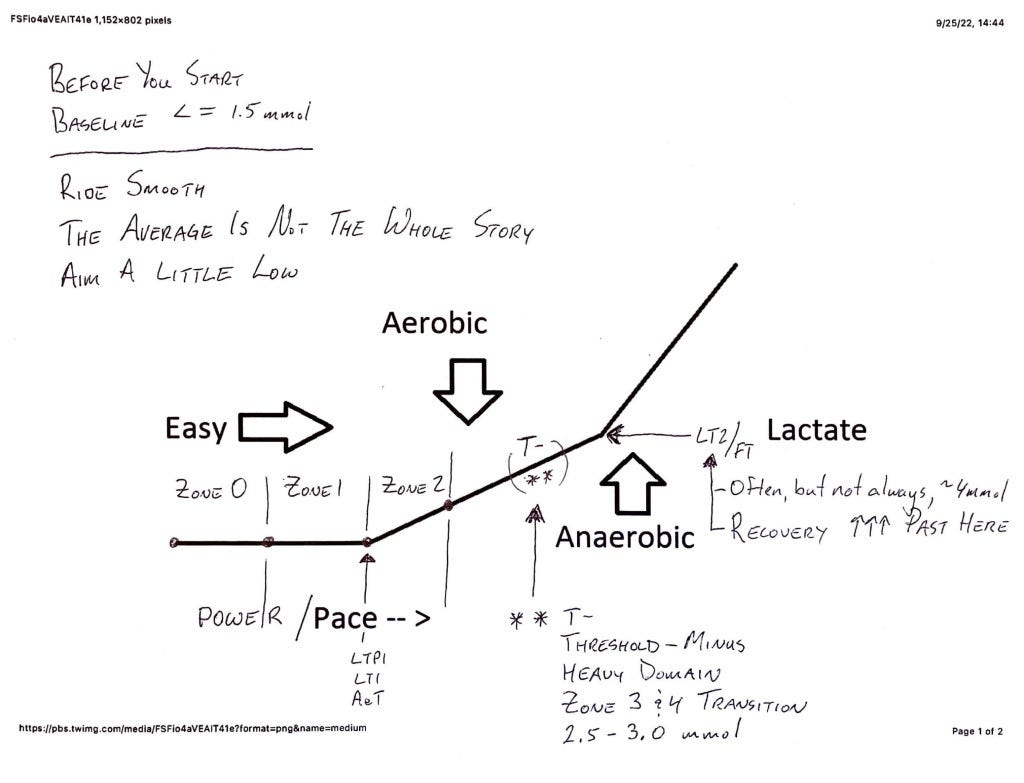Coach Ryan Dreyer came over and took himself to the limit for our benefit.
We ramped him from:
Can Barely Feel It
To Life-Max Heart Rate
I pulled everything into a video (embedded below) and wrote this article to help you.
The video covers:
Equipment We Used
Test Protocol
Reviewing Data
Setting Targets
Training Prescription
You do not need to test lactate to gather useful data, but it helps. You can feel everything discussed below.
Pay attention to breath markers every time you train.
The last ten minutes of the video, I cover training prescription:
Higher Cadence Work
Comfortable Cadence Ranges
Cruise Intervals
Big Gear Work
VO2/Threshold Blocks
Sprints
Protocol
The protocol we used:
Start very easy
Use small steps (~0.25w per kilo)
5-minute steps until athlete feels their breathing deepen
10-minute steps until athlete starts to pant, lightly (FT/LT2/LTP2/CP)
As the test moves above 2nd Threshold, increase step height to 30w and reduce step duration to 3 minutes
Two steps are usually enough to max out
Thresholds, Turnpoints and Tips
The points we want to notice:
1st Threshold: As your body leaves baseline lactate, you will feel a deepening of breath. I call this aerobic threshold.
Threshold-Minus: usually the step with lactate in the 2.5-3.0 mmol range. Breathing is audible but athlete is not panting. I call this effort “Happy Hard.” A moderately-strong effort, athlete will need to pause when answering questions.
2nd Threshold: athlete will start to pant; legs will burn a bit. The clock is quickly ticking towards slowing down. Often, but not always, around 4 mmol of lactate.
What makes the above tricky:
Athletes have a WIDE range of durations they can sustain at each point
Everything above 1st Threshold is an estimate
Athletes often blow past 1st Threshold without noticing
This is a long test, 75 minutes for Ryan. You need to be fit to get through it.
While you can find the markers without lactate, lactate makes your task easier.
How’d it turn out? See below.
Defining Domains
Unsure about Domains & Zones? Article here with embedded video.
Key Points:
Moderate Domain: anchor on aerobic threshold, the border between Zone 1 & 2
Heavy Domain: anchor on threshold-minus, the border between Zone 3 & 4
Severe Domain: above 2nd Threshold
To help you visualize the above, I drew a picture.
Ryan’s Chart
Y-axis is lactate
X-axis is watts
HR in parentheses
Moderate Domain
Ryan steps up 0.3 mmol when the power increases to 200w and reaches 2.0 mmol at the 220w step.
We know he averaged <200w at an Ironman race, and he reports high 120s bpm is a comfortable endurance effort.
So, I drew the Moderate-Heavy transition at ~200w.
I’d place Ryan’s aerobic threshold at the last point before lactate stepped up (180w). I’d expect endurance segments to average ~180w, while he sits 170-200w.
Heavy Domain
In this test, Ryan had a greater heart rate response than lactate response.
Suppressed lactate response can be a sign of fatigue. The end of the test saw Ryan achieve a life-max cycling heart rate. So, I’m ruling out fatigue.
For training, Ryan should target Heavy Domain sets 225-250w, with interval averages at the lower end of the range.
Estimating 2nd Threshold
On the chart, you’ll see I drew a line from 1st Threshold to the final data point.
For 2nd Threshold, I estimated the part of Ryan’s curve that’s furthest from the line. Gave us 280w. This is modified d-max (max distance method).
2nd Threshold estimates:
Compare to season bests
Precision is an illusion
You are seeking to understand the transition zone
Ryan’s bests for the year:
300w for 30 minutes
257w for 60 minutes
Placing the transition zone 260w to 280w seems about right.
Severe Domain
Once Ryan crossed 260w he lasted 6 minutes and achieved a life-max heart rate. The last step was 313w, measured at his crank.
For the Severe Domain, I like to consider the athlete’s 6-minute best. Ryan’s 6-minute best for 2022 is 325w.
For base training, I use 285-305w for Severe Domain Sets.
As Ryan moves into spring, I’d want to dial in the Severe Domain targets.
There is material upside in Ryan’s Severe Domain, but smart use of the Heavy Domain is what will make him faster.
Metabolic Grey Zones
Experienced readers will notice:
A gap between the Moderate and Heavy Domain recommendations (200-225w)
A gap between the Heavy and Severe Domain recommendations (250-285w)
20+ years ago we called the gaps grey zones. These days they are called Domain Transition Zones.
Whatever you call them, it is better to train inside the Domain you are seeking to target.
Altitude
Don’t use sea level bests to set pace/power targets you’ll use up high.
Ryan tested at 5500 ft / 1675 m
Locally, he often rides to 10000 ft / 3050 m
With a bit of effort, Ryan can get to 14000 ft / 4250 m
When moving higher, cap heart rate and accept the pace/power that results.
Use Of Cadence
Ryan’s cadence averaged 83 rpm across the test.
For athletes with this profile, I like three types of workouts:
Easy Effort: aim for 92-95 rpm and sit below aerobic threshold, 20-60 minutes duration
Moderate Domain: inside an Endurance Ride, 6-20 minutes duration with cadence ~92 rpm
Heavy Domain: insert segments of 1-4 minutes duration inside lower cadence intervals. See my Bike Sets.
If you prefer cadences <85 rpm then heart rate will pop when you lift cadence >90 rpm. Back off the power/pace to moderate the heart rate increase.
Challenging cadence is an effective way to progress your endurance sessions.
Your cadence profile is a highly trainable adaptation.
Cruise Intervals & Big Gear Work
Heavy Domain segments & sets:
Cruise Intervals: choice, or higher, cadence intervals placed into an Endurance Ride
Big Gear Work: low cadence intervals inserted into an Endurance Ride, or the main event in a shorter ride
Specific ideas in my Bike Sets.
Where To Focus
It’s easy to get wrapped up in main sets targeting the Heavy Domain, or higher.
That would be a mistake.
Keep 80% of your training in the Moderate Domain and mix your cadences.
Back To Table of Contents










Incredible write up! Thank you so much for sharing your knowledge and helping me improve. Eager to put this to use!
Great article! Thanks!